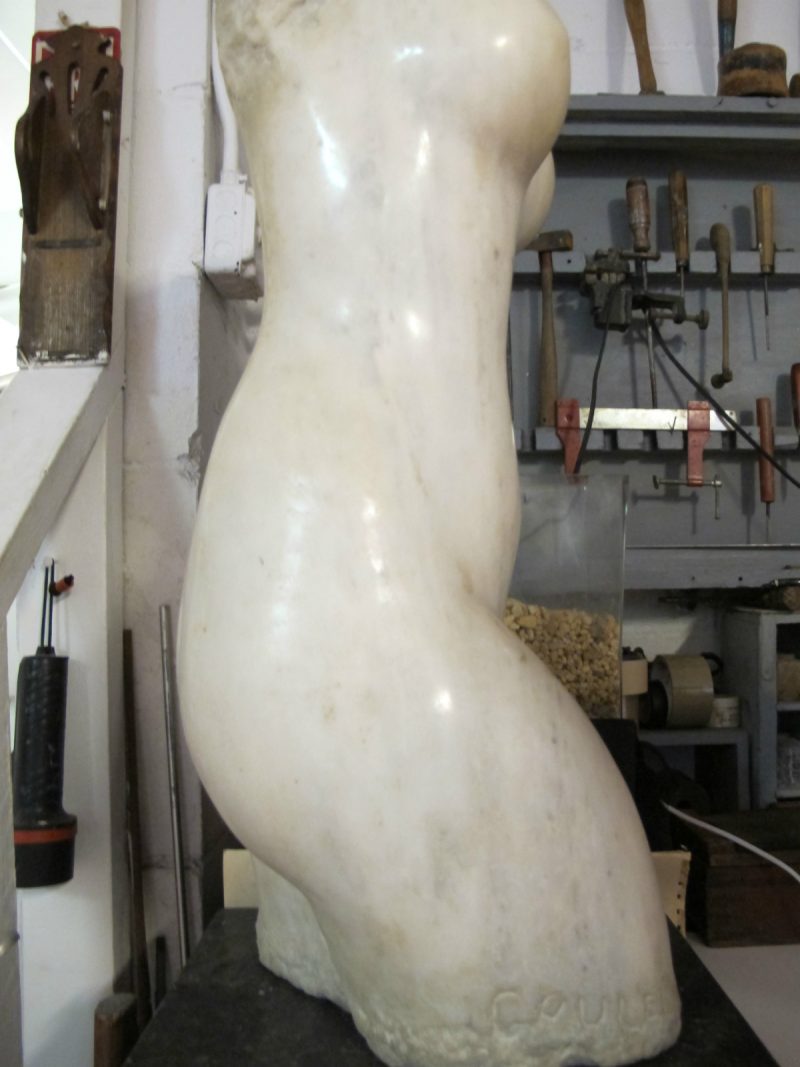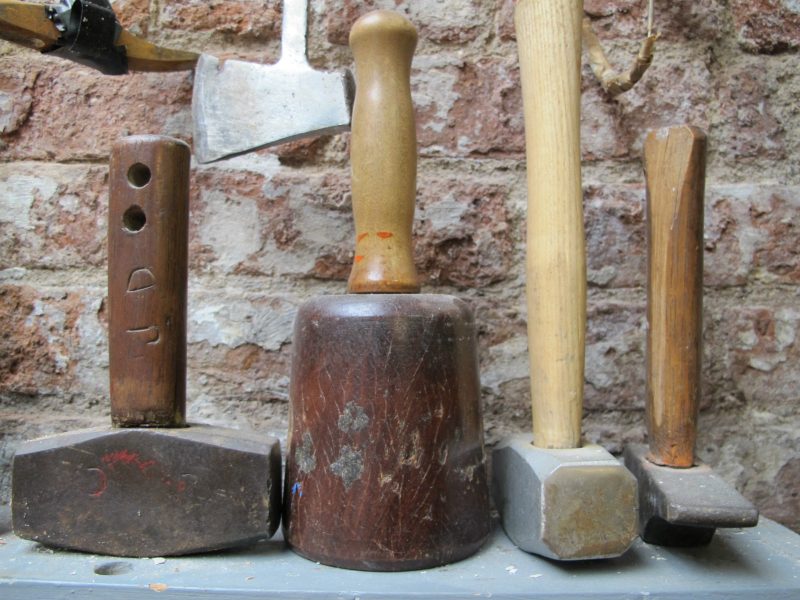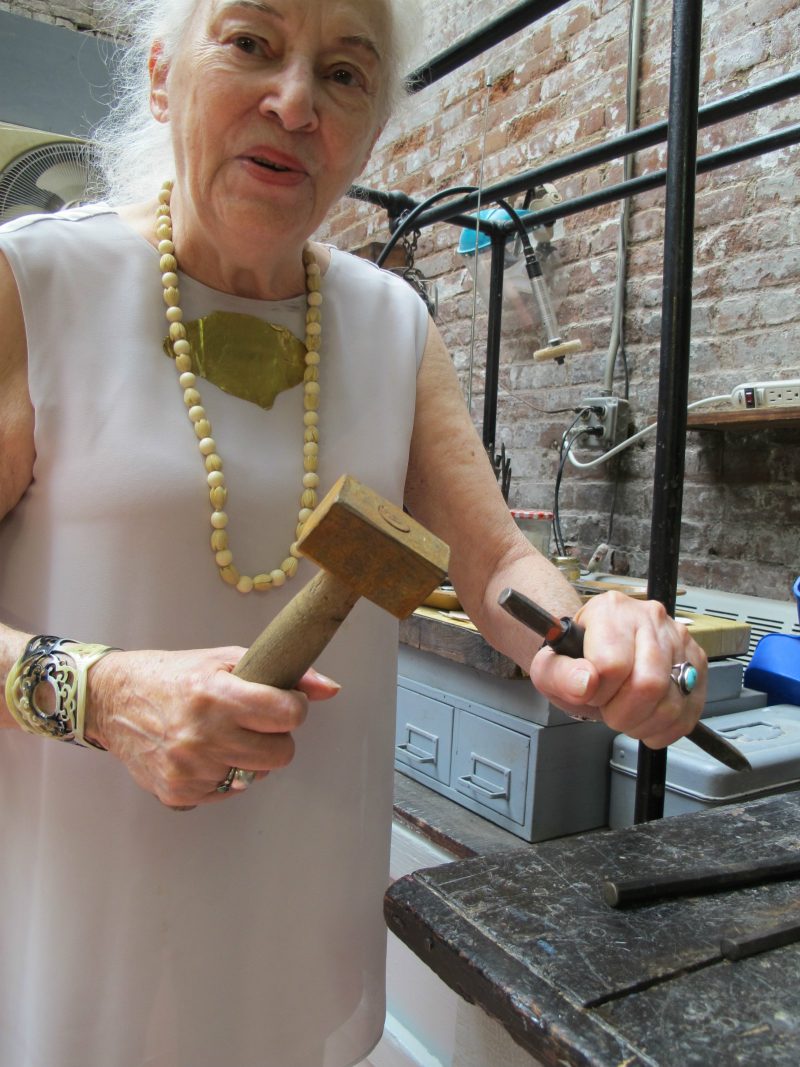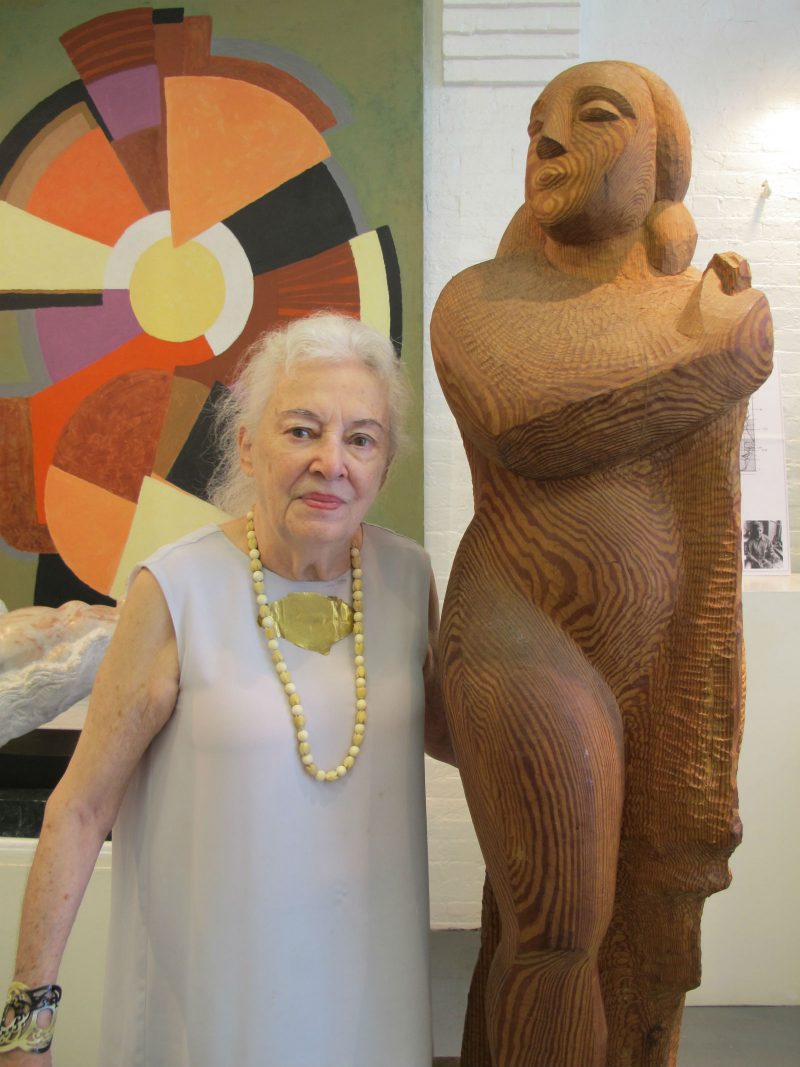
At 91, Lorrie Goulet’s dedication to the carver’s art is unwavering, even though she cannot wield the carver’s tools like she could as a young woman. Throughout a recent wide-ranging conversation I had with her at her home and studio in Chelsea, I was struck by Goulet’s deep commitment to the physical work of carving, its tools, techniques, and materials. Her eyes light up and her gestures become animated when talking about stone, its myriad types, colors, and textures. For Goulet, stone–her primary material–is alive, and each stone has its own personality. “I put my life with the stone’s life,” she told me, following up with “I don’t have many stones left.”
This love of carving brings with it a certain inescapable sadness, as she has seen the field of sculpture transform radically since the start of her career in the 1950s, moving away from object-making to Minimalist multiples, installation-based works, video, performance, and the embrace of casting in synthetic materials like resins and polymers.
In addition to talking about her sculptural practice, we discussed her family background, her work as a teacher, and her hopes for her legacy.
From Broadway to Inwood Hill Park
Born Lorraine Goulet in 1925, the future sculptor had her first formative art encounters as a child in New York City. Neither of her parents had backgrounds in the visual arts, although her mother had unrealized ambitions to be an actor and her father was an actor and agent. When Goulet was a young child, perhaps as young as 6 or 7, she would visit her father’s Broadway office, where he would be auditioning fan dancers and chorus line girls for shows. That was her introduction to the (nearly) naked female body, and later the female form would become the primary subject of Goulet’s sculpture.
In 1932, when she was just 7, Goulet began taking pottery classes at the Upper West Side Inwood Pottery Studio with the studio’s founder, Aimee Vorhees. Goulet worked with Vorhees for four years, and cited her as formative influence who encouraged the young girl in her artistic ambitions and provided valuable technical training. Rather than making cups and bowls, though, Goulet determined that she “wanted to make people” after walking in on an artist creating a clay portrait of a woman.
The family moved to Los Angeles for her dad’s business and at age 18, Goulet moved back east to attend the legendary Black Mountain College near Asheville, NC.
Summer at Black Mountain
The communal setting and shared sense of artistic purpose that Goulet encountered at Inwood Pottery Studio were present on an even larger scale at Black Mountain College. Goulet said that she was drawn to this unique institution in the Blue Ridge Mountains after reading about it in Louis Adamic’s My America (1938). Adamic characterized the college as a utopian artistic experiment, a reputation that Black Mountain enjoyed since its foundation in 1933. In contrast to other contemporary art schools, at Black Mountain the curriculum emphasized method and process over finished results, and instructors and students learned from one another in a more democratic, less hierarchical educational environment. Goulet insisted on going to Black Mountain, rather than take an extra math class so she could go to a more traditional college.
Goulet studied painting with Bauhaus teacher, Joseph Albers, who had fled Nazi Germany together with his wife, Anni, who taught Goulet weaving and textile arts. The mix of “high” and “low” art was in keeping with the Bauhaus belief in the unity of craft traditions and the fine arts. The Albers fostered a community of local and international talent, bringing renowned artists to teach intensive summer courses at the college. One such artist was José de Creeft (1884-1982), a Barcelona-born sculptor who had trained in Paris. He offered classes in direct carving (that is, carving directly into the material without reference to a model or maquette) in stone and wood at the summer school of 1944, teaching students to make their own tools and build a forge. Goulet met de Creeft at the Black Mountain summer school, and the two married in 1944 when de Creeft was 60 and Goulet–40 years his junior–was just 19 years old.

Goulet’s long professional career has been under-sung because as a woman and wife she was seen less as an independent artist than as an acolyte of her husband, whose work hers closely resembles. Art history is filled with wives who produce in the shadow of their husbands. Margaret Eakins, wife of Thomas, is one local historical example. Goulet’s work is not included in the history books, whose accounts of the era prioritize her male teachers and peers. Even in the most recent accounts of Black Mountain College, sparked by an important 2015 exhibition “Leap Before You Look: Black Mountain College 1933–1957,” Goulet’s artistic identity is subsumed into that of her more famous husband. Contrary to what these accounts would have you think, Goulet maintained an independent career as an artist and teacher, preferring to keep her maiden name, and assertively signing her pieces “L. Goulet,” as we see in 1970’s “Nessa.”

While Goulet didn’t have much to say about feminism or women in the arts, it seems to me that being a woman shaped her work as both an artist and teacher. In choosing to depict women, she was not representing herself, she said, she was being herself–a distinction that points to her sense of being female. As a white woman working in the pre-Civil Rights-era, Goulet never directly engaged with issues of race, class, and gender, unlike another overlooked female sculptor of the mid-twentieth century, Elizabeth Catlett, an African American artist for whom those issues–race, gender, class–were front and center.
Nor was Goulet interested in more experimental trends in sculpture. While artists like Louise Nevelson were beginning their career as sculptors in the 1940s experimenting with found objects, embracing the new aesthetics of Abstract Expressionism, Goulet resolutely stuck to the human, largely female, form as her subject matter.
Goulet never mentioned either of these artists in our conversation, and seeing her work in isolation in her first-floor studio made me wonder what it would be like to see her sculptures juxtaposed with those of her contemporaries. Much like the Denver Art Museum’s recent show, The Women of Abstract Expressionism, it seems to me like there’s an untold story about women sculptors in the mid-twentieth century that has the potential to reshape our understanding of the canon and stylistic categories of art history.
From student to teacher
Throughout the 1950s and 1960s, Goulet stayed busy with numerous solo and group exhibitions, as well as with her young daughter, Donna Maria. She spent most of her time in New York, occasionally traveling to nearby cities like Baltimore, Washington, D.C., and Philadelphia. In November 1950, she was part of a group show of women sculptors at the Philadelphia Art Alliance. Goulet told me that in the 1960s, Julian Levi, then teaching at PAFA, asked her to join the faculty, but she couldn’t make the regular commute given her family responsibilities. Instead, she left a long legacy as a teacher in New York and continues to mentor one final student, who comes to Goulet’s studio every Thursday to work.
Goulet taught at the New School for Social Research from 1961 until 1975, and at the Art Students League from 1981 until 2004. She described to me how when she first started teaching, there were no women on the faculty, and sculpture was very much a man’s world. She encountered initial resistance from male faculty and students, but told me that men gradually came around to the idea of having a woman teaching sculpture, while women were eager to study with her.
How Goulet responded to that resistance is unclear. But while she was not very revealing of her personal struggles, she told me she was “happy in her work.”
An independent woman
In the 1960s, the couple purchased a home in the Chelsea neighborhood of New York, where Goulet has lived ever since. While her husband was still alive (he died in 1982), Goulet had a studio around the corner, while de Creeft’s studio was at home. Now, de Creeft’s remaining sculptures are kept in the basement of the house, while Goulet uses his former studio for her own work. The Spanish sculptor’s presence is felt most vividly in the tools that Goulet inherited from him, and which she continued to use until poor health limited her ability to sculpt.

Beautifully worn wooden mallets and chisels, some of which have the initials “J de C” carved on them, hang on the wall. Bearing the traces of decades of touch and use, they speak to a tradition of stone carving that has fallen into decline. When I asked her to show me how she used some of these tools, Goulet ably took up the mallet and chisel, moving with the long-accustomed rhythm of the stone carver, hefting the mallet and striking the chisel. She spoke to me of the music of carving, the rhythms of the body and the stone working in tandem. This intimate look at the sculptor at work–at age 91–was impressive and gave me insight to the rhythms of her finished work.

Her downstairs studio and exhibition space contains a small selection of the many sculptures Goulet made during her career, chosen to remain in her collection and not be sold because she is exceptionally fond of them. Goulet works with galleries in both New York and Naples, FL. Although she prefers to work in stone rather than wood, one of the most impressive sculptures to my mind was a large figure of a standing woman carved in Georgia pitch pine, entitled “Alba.” Goulet characterized her as a “large, independent woman,” and, indeed, at over five feet in height this is the largest sculpture in the studio. Remarkably, “Alba” was completed in 2000, when Goulet was 75 years old. She skillfully worked with the grain of the wood, using its natural lines to enhance the articulation of the figure, especially her face. “Alba” looks strong, capable, and if not eternal at least durable–much like the artist herself.










